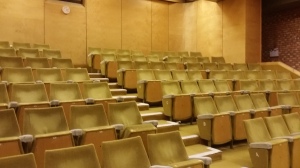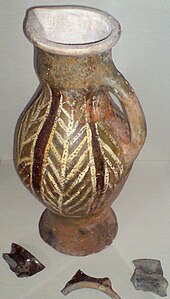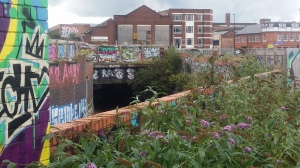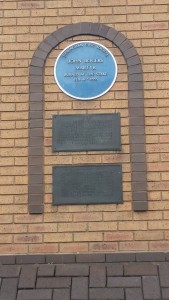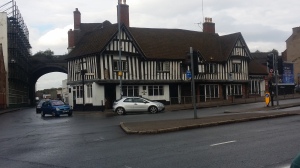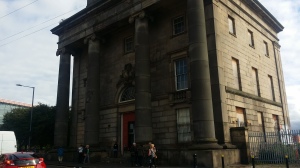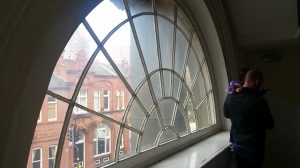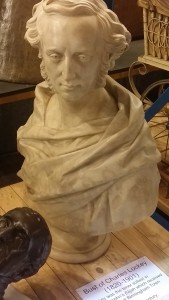Hidden Spaces
I am a history fanatic and it is safe to say that the study of the
past takes up a lot of my time. I am very fortunate to be a Co-organiser
of the Birmingham History Network (BHN). The BHN is a
meetup
group which is designed to bring like minded people together and
organise events. Hidden Spaces was my second organised tour for the BHN
and it formed part of
Birmingham Heritage Week 2015.
There was so many events to pick from over the week, and it was very
difficult to filter through and pick something to do. In my opinion
there was too much choice. Although if I run this event next year I
think from experience I will be able to plan and organise the event a
little better. I decided to pick a selection of venues that are normally
closed to public viewing (which the exception of a few days each year).
Often I walk past their buildings and always wonder what lies behind
the closed door.
Birmingham Municipal Bank
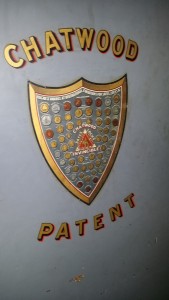
First up with the old Municipal Bank, which was first suggestion by
Neville Chamberlain (who is perhaps more famous for being Prime Minster
during the Outbreak of World War Two) in 1915. The idea of the Bank was
to courage workers to deposit their savings which would generate a 3.5%
interest which would be used by the Government, predominately to help
the war effort. The Bank was created by Act of Parliament in 1916. After
the war the Bank survived and it moved to it’s current position in
1933. This building located on Broad Street was the headquarters of the
Bank.
This is a big and very beautiful building. There are many saves
behind this bank, and the building has a spooky element of being a ghost
shell. I am not sure when the bank stopped being operational, but it
closed because it was too big and too costly to maintain. I was
fortunate enough to meet a woman who used to work here in the 1960s and
she talked about the beautiful cashier’s desk that used to be in the
main room as soon as you walk in…alas it has now gone and the building
is just an empty shell. Another lovely bonus was that someone else in
the group knew one of the people in charge of the Heritage Open Day and
he very kindly gave us a tour around the other safes. The big empty
vaults hold a silent history of what was once a very busy bank.
I think it’s an absolute shame that this building is not in use
today. I can understand why it is too costly for a bank, but I was
thinking that it is right next to the Registry Office. I think this
building would be fantastic to be reused as a wedding venue…it has
beautiful charm and room to be able to have a wedding and a
catering/dance facility within it. Some of the former managerial offices
could also be turned into Hotel rooms. Although there would be a
problem with toilet and washroom facilities which are at present would
be limiting. Nevertheless I think it would work really well as a wedding
venue.
Curzon Street Station
I am quite clearly not a photographer, so my photos are appalling.
Curzon Street Station was opened in 1838…but what is interesting is that
this building was only partially built. There were meant to be two
wings to the building, which appear in drawing plans but were never
built. That’s why this building has the appearance that something is not
quite right…almost missing. People often think that something has been
removed from the building, in fact, the opposite was true – it was never
added.
I was a little more disappointed with Curzon Street Station – it was
lovely to see round the building…but there was no one really giving
tours around and as we did not have someone in the group who knew
someone to give a private tour, nor someone who worked here there wasn’t
much more to do than walk around. There were a few informative boards
on one wall – but it was mostly empty. I thought it would have been
better to see if there were any photographs of Curzon Street within the
archive and perhaps of used one of these empty rooms to display that. I
loved a collection of old keys that had been left in one of the rooms,
it was like it had been left there on Friday night ready for Monday
morning and it never opened that Monday, the cobwebs in the place gave
it a fantastic touch. There was talk that this building was going to
become a Museum, but I overheard someone discussing with someone else
that it would have cost millions to comply with health and safety and
they just couldn’t afford to make it a museum.
Birmingham Hippodrome
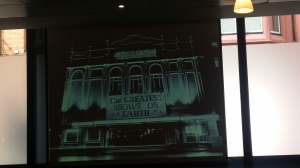
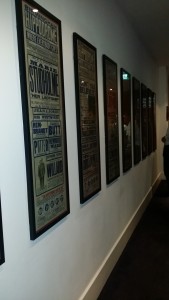
I
thought the Birmingham Hippodrome did a fantastic job for Heritage
Week. I loved the two women in traditional Victorian dress singing
traditional turn of the last century songs, including ‘My Old Man’,
although there is a photo of me singing this song somewhere (I am
praying it doesn’t end up in the Birmingham Mail of something like
that…), they were brilliant and great fun. I’m sad I did not get a
picture of them. There was also a lovely guide who talked a bit about
the posters which you can see on the left and briefly about the origins
of the Hippodrome. He suggested that often Hippodromes were created to
make a loss, and I know that often venues today make a lost. I thought
they would have been more popular prior to the onset of Cinemas, Radios
and Tvs; but apparently even back then they were build by wealthy people
as a status symbol, but not designed to be a money spinner. Another
great thing about the Hippodrome was the Historical Talk, one of the
guides gave, which was an hour long sit down presentation about the
History of the Hippodrome. I really enjoyed it and it was very
informative.
Museum Collections
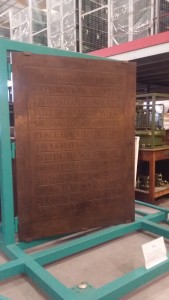
This
was around about 2 O’Clock and having started at 10 O’Clock, a large
part of the group decided to call it a day. A few hard corers stayed on a
braced themselves for a 30 minute walk across town to go to the Museum
Collections building. The Museum Collections building is like a big
warehouse that houses the artefacts the museum has which are currently not on, or never go on display. It waa like an Aladdin’s Cave of Historical Goodies. It also answered a question
I have often wondered. I look around and see some beautiful sculptures
and busts of people and sometimes during refurbishments these disappear
and never come back. I often wondered where they go and if they are
destroyed. Turns out a lot of them are stored in the Museum Collections
and they have a fantastic collection of random things. It was great
looking through them. Although it was nearing the end of the event and
the building was getting ready to close, so it was rather a rushed look
through.
An expected bonus
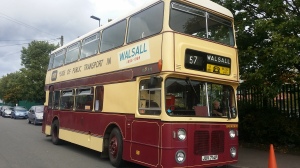
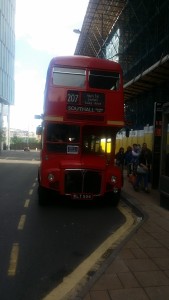
By this point it had been a long and tiring day, the group had done a
lot of walking and exploring and it was safe to say we were looking
forward to going home. The prospects of a long walk back into town was
not appealing, however as luck would have it a man stopped me and said
there were two vintage buses which were talking people back into Town.
We decided to leave on the second to last bus and travelled on the
London Red Bus. We were speaking to the ‘Conductor’ who was organising
the stops, he said we’d turn right and stop outside Snow Hill Station,
unfortunately we didn’t and the Conductor had no way of talking to the
Driver, as unlike modern buses the Driver was completely isolated from
the passengers on the bus. We ended up going back to Museum collections
and we were about to go and get the train, when the Conductor said he
was making one final trip into town and would not be coming back to
Museum Collections. So we got a second trip round on the bus…which was
fantastic and a perfect end to a very historical day.
